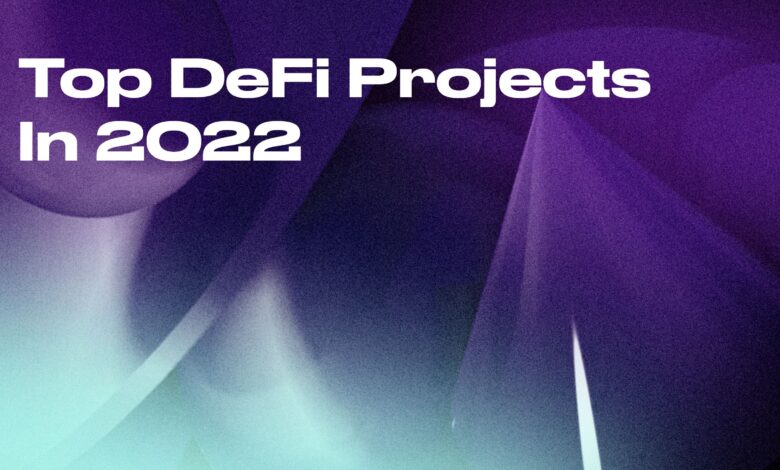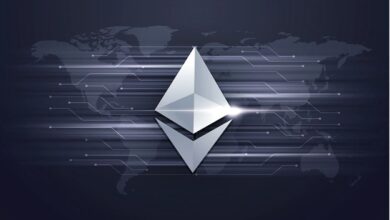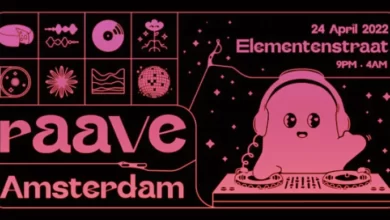Top 10 Defi Projects In 2022

Decentralized finance, or DeFi, has been a developing area of the cryptocurrency market, with over $71.35 billion in value locked across all networks (at the time of writing). And this is despite the present decline in the cryptocurrency market as a whole.
Many successful projects are exploding in the DeFi field, taking advantage of blockchain technology’s finest features to displace established market makers, do away with the need for intermediaries to fuel decentralized ecosystems, and make finance accessible to a more extensive range of people. DeFi might be the solution if you need a loan or if you’re an entrepreneur looking for support for your next major project.
Still, trying to figure out where to begin? The top 10 DeFi projects (and DeFi tokens) to be aware of in 2022 have been compiled by us.
What Is Decentralized Finance (DeFi)?
Decentralized finance refers to a wide range of financial operations that happen without the involvement of any middlemen or centralized authorities, such as banks or the government.
You may encounter DeFi transactions like loans, transfers, exchanges, and insurance similar to traditional financial transactions. But with DeFi, we may deploy intelligent contracts throughout the system to enable a truly decentralized economy, in contrast to conventional fiat transactions, which a third party must validate.
This decentralization approach may apply to all services that use cryptocurrencies and blockchain-based protocols, going well beyond payments, lending, and borrowing.
All of this can aid in reducing bureaucracy, speeding up transactions, and enabling a more open and accessible financial system for those who might otherwise be cut off from the traditional one.
Top DeFi Projects In 2022
Polygon
One of the most notable DeFi projects in the crypto world is Polygon (MATIC), which uses its remarkable capabilities to facilitate scalability and blockchain interoperability. Let’s look more closely.
A decentralized application ecosystem and a Layer 2 scaling solution for Ethereum are both called Polygon. The platform takes advantage of the Ethereum blockchain to raise intelligent contracts at a rate of 72000 transactions per second, which is much faster than what other blockchains can provide. Polygon offers some scaling techniques, including sharding, to do this.
The platform’s capacity to link Ethereum-based projects maximizes the structural advantages that blockchain has to offer. This is another fantastic feature. Polygon currently hosts more than 19,000 decentralized applications in total (DApps). This top DeFi project first served as a quick, low-cost, and simple method to enter the decentralized financial space, but it has since grown to support a variety of use cases, including blockchain gaming and NFTs.
Its native ERC-20 token, MATIC, is used to cover transaction costs, reward users who stake the token and protect the proof-of-stake network. The network charges fees that vary from $0.0005 to $0.2.
Aave
The open-source DeFi protocol Aave is used for crypto borrowing and lending. Since its debut in 2017, Aave has played a significant role in enabling decentralized apps and supporting the DeFi ecosystem, which allows users to lend and borrow cryptocurrency in return for a variable interest rate. Aave can therefore be seen as an open-source liquidity pool.
Users can receive a reward for staking their assets through the platform that automatically adjusts to the entire supply and demand in the protocol. With Aave, you can use the AAVE DeFi coins in yield farming, liquidity pools, and staking if you’re interested in making passive income with DeFi, a subject we covered in our previous piece.
Built on the Ethereum blockchain, Aave provides access to a wide range of cryptocurrencies. And despite the fierce competition in the cryptocurrency loan and borrowing market, this top DeFi project has maintained its lead.
Another remarkable aspect of this protocol is that it is decentralized and run by Aave governance, allowing holders of AAVE tokens to propose proposals and vote on important decisions.
Polkadot
One of the most significant issues with blockchain technology is interoperability. DeFi projects are likewise impacted by this, which restricts access to the more substantial industry and confines consumers and developers to a narrow ecosystem. In this setting, Polkadot has emerged as an encouraging platform that seeks to address some of these problems.
As a next-generation blockchain, Polkadot is an open-source network that encourages connectivity and interoperability while also attempting to support a heterogeneous multi-chain framework by allowing separate chains to communicate and conduct transactions in a highly secure setting. Another significant advantage of Polkadot is that it manages security and transaction validation and combines many blockchains.
The DOT token, which may use for network validation and governance, is this DeFi project’s native coin.
Polkadot will undoubtedly continue to offer new solutions that can be used with DeFi as technology advances.
MakerDAO
One of the most well-known Decentralized Exchanges (DEX) based on the Ethereum network, MakerDAO, was introduced in 2017. With all transactions managed by smart contracts, this decentralized autonomous organization functions as a peer-to-peer lending and borrowing platform for cryptocurrencies. At the peak of the cryptocurrency market, the value of all the smart contracts created using this technology exceeded US$600 million.
The DAI, an ERC-20 token that is soft-tied to the U.S. dollar, is what powers MakerDAO. A comprehensive range of financial services, including borrowing, lending, payments, and much more, can be performed using the DAI stablecoin.
Along with supporting new financial instruments and offering new infrastructure layers for other protocols in this crypto area, MakerDAO’s Multi-Collateral Dai (MCD) System expands the prospects for DeFi initiatives even further.
Uniswap
You will want to notice the term Uniswap in a list of the top DeFi projects for 2022.
By utilizing a cutting-edge trading strategy known as an automated liquidity protocol, this open-source protocol has been able to rank among the top decentralized cryptocurrency exchanges on the Ethereum blockchain. Users can conduct transactions in a peer-to-peer style on Uniswap, completely decentralized and completely different from other exchanges like Coinbase, FTX, or Binance. Users may even list DeFi coins on the exchange for no charge. The attractiveness of a DeFi project like Uniswap becomes apparent when you consider the absence of intermediaries, the minimal fees levied, and how simple it is to swap tokens.
The platform’s non-custodial nature and security are additional reasons for its popularity. In addition to all of this, the native digital coin of the company, called UNI, has one of the highest market caps among all cryptocurrencies, standing at $5.6 billion at the time of writing.
Compound
You can borrow cryptocurrency using the decentralized, blockchain-based Compound protocol based on an algorithmic, autonomous interest rate. As of the publishing of this article, the platform’s total value locked (TVL) is about $2.3 billion. How does the DeFi initiative operate, then?
To begin with, Compound Finance’s algorithm enables users to profit from lending their tokens to a DeFi market by charging interest on those loans. On the other hand, Borrowers have direct access to cash without needing an intermediary or centralized authority.
Accounts on the blockchain can supply money to the protocol or borrow assets using token contracts (holding other assets as collateral). These smart contracts use Compound to maintain balances and apply algorithmically determining interest rates.
In addition to supporting a wide range of cryptocurrencies, this DeFi platform also powers its native COMP currency. Compound allows developers to create innovative DeFi products.
Curve
Due to its reputation for composability and reliability, Curve Finance is one of the most well-known DeFi platforms and a top decentralized exchange. This complete DeFi project also functions as a famous automated market maker (AMM) platform, allowing for excellent token exchange efficiency with low fees and little slippage. Investors have taken notice of these traits, especially in light of the current crypto market crash.
The curve is based on the Ethereum network, like other DeFi protocols, and lets users trade stablecoins and other ERC-20 tokens. By allowing other traders to exchange their tokens for higher values, cryptocurrency users can also make more fees from their tokens.
The curve is one of the most essential DeFi projects since it focuses on bolstering liquidity pools with assets that have comparable prices. The platform promotes incorporating outside DeFi protocols to foster a healthier ecosystem and provide Curve users with more benefits.
Additionally, the CRV DeFi coin has grown reasonably well-liked among many cryptocurrency investors.
Ardana
Ardana is a decentralized exchange stable asset liquidity pool and on-chain asset-backed stablecoin system built on Cardano. With minimal risk income from fees for liquidity providers, this DeFi concept allows for very efficient trading between stablecoins and identical assets. The platform is focused on the decentralized exchange (DEX) Danaswap and the stablecoin dUSD. The purpose of dUSD is to make it easier for cryptocurrency users to borrow money against their Cardano tokens, such as ADA. At the same time, the decentralized exchange enables users to conduct transactions like token trading, earn interest on their deposits, and receive other benefits in exchange for supplying liquidity to the system.
Compared to some of its competitors, Ardana significantly simplifies the lending and borrowing process by removing the need to convert the native currency, the American Dollar (ADA), into stablecoins. Instead, users can deposit ADA directly into Ardana and review rewards in proportion to the total value returned as a dUSD loan.
Centrifuge
Centrifuge, which bills itself as the “first protocol to connect DeFi to the real world,” seeks to integrate the untapped multi-trillion dollar real-world assets (RWA) market into decentralized finance. As a result, it has elevated to rank among the top DeFi projects for 2022.
Users of this platform’s multi-chain DeFi protocol can tokenize tangible assets like bills, properties, and royalties to assist borrowers in obtaining finance without the aid of banks or other financial intermediaries. When this crypto currency is tokenized, it may be used as security to access funds using Centrifuge’s lending Dapp, Tinlake. The platform’s pooled liquidity allows investors to receive steady yields, while entrepreneurs and small enterprises searching for finance may find this helpful.
A centrifuge is a well-known blockchain platform partnered with Polkadot, Ava Labs, and Kusama, as well as receiving funding from companies like Moonwhale and Fenbushi.
Synthetix
The Synthetix Network Token, an open-source, decentralized finance protocol based on the Ethereum blockchain, powers Synthetix (SNX). More specifically, Synthetix is the technology that underpins the issuance of synthetic assets known as Synths and brings off-chain financial assets on-chain. This function is well-liked because it exposes consumers to financial instruments other than crypto assets.
You can find a Synth based on the value of the U.S. dollar, for instance, by searching for the symbol sUSD. Synths are created to replicate the value of real-world assets. The platform also uses specialized data feeds, known as oracles, to track the value of a wide range of support, giving customers exposure to profits or losses in numerous markets. The network is more energy-efficient than other platforms because it is secured using a proof-of-stake technique.
Synthetix has a remarkable $518.08 million locked in its contracts, making it one of the most significant and well-liked DeFi projects currently available.




